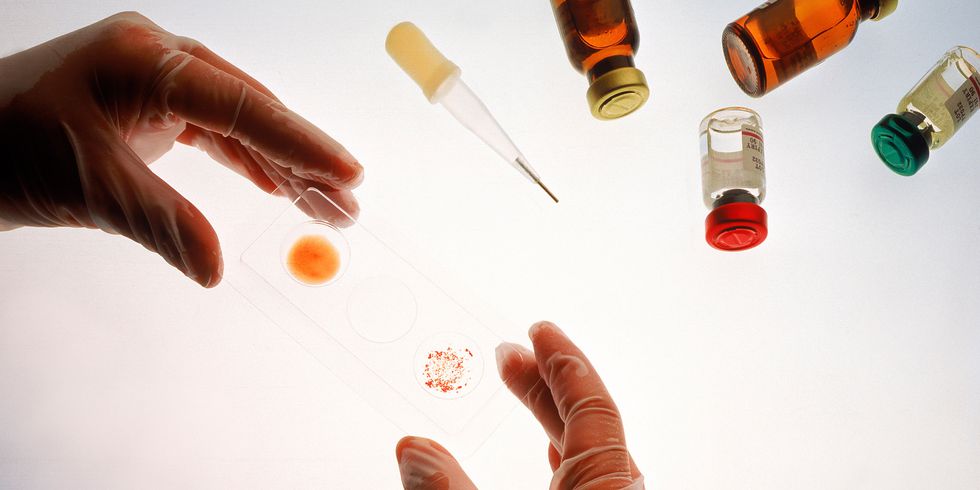
First off, let’s be clear: If you’re sexually active and not in a monogamous relationship, you’re at risk for sexually transmitted diseases and should be screened, full stop, drop the mic. And yes, that’s true even if you’re not experiencing any STD symptoms, says Khalil Ghanem, MD, PhD, an associate professor of medicine at Johns Hopkins University School of Medicine.
“The majority of STDs—be it gonorrhea, chlamydia, or herpes—tend to be asymptomatic, meaning they don’t cause symptoms,” Ghanem explains. “So a majority of people who have these don’t know they have them.”
If most STDs don’t cause symptoms, why should you worry about them? Apart from the pain, skin lesions, or other symptoms that may eventually show up, you could infect your partner, Ghanem says. And even if your mate is also asymptomatic, both of you could be at greater risk down the road for serious complications like arthritis, infertility, or some cancers—particularly cervical, anal, or throat cancers.
It’s also important to remember that “sexually active” includes people who are having only oral—either giving or receiving. “Syphilis, herpes simplex, gonorrhea, and potentially even chlamydia can all be transmitted by oral sex,” says Christine Johnston, MD, University of Washington Infectious Disease Specialist.
Okay, you get it, and you’re ready to be tested. Here’s exactly what you need to know about the process.
1. “Testing” isn’t quite the same as “screening”
While the terms are often used interchangeably, “testing” and “screening” aren’t quite the same, Ghanem says. Testing is what your doctor does if you’re showing symptoms of an STD—like if you have sores on your genitals, which could be indicative of syphilis or herpes. “If you don’t have symptoms but your doctor decides your sexual activity warrants a check, that’s screening,” he adds.
2. Different STDs—and kinds of sexual activity—can change your doctor’s screening methods
Unfortunately, a single blood or urine sample isn’t enough to tell your doctor if you have an STD. While syphilis and HIV require blood samples for screening, gonorrhea and chlamydia may require either a urine screen, a throat swab, a rectal swab, or all three, Ghanem says. The same is true of herpes. “If you have a lesion, you’ll need a swab of the lesion for testing,” he explains. “If you don’t have a lesion, it’s a blood test.” You may have to take a number of tests to ensure you’re STD free.
If you’re having unprotected oral, anal, or vaginal sex, each of those activities may require a different screening or testing method to check for an STD, Ghanem says. For example, if you’re having unprotected oral and vaginal sex and your doctor is concerned about gonorrhea, you need to take a urine test and have your throat swabbed, Ghanem says. “If you’re only taking a urine test for gonorrhea, your doctor may miss an infection in your throat,” he adds.
This is important to note because many patients are hesitant to tell their health care providers about their specific sexual habits. Physicians, too, are often embarrassed to ask about oral and anal sex, Ghanem says. “It’s important that your physician knows all your sites of exposure,” he adds.
3. Urethra swabs (shudder) are a thing of the past
There was a time when some STDs required men to stick a cotton swab inside their urethra—which is the hole in the tip of your penis. Fortunately, Ghanem says those days are history. “Men found the urethra swab uncomfortable or scary, but now all those STD tests are urine based,” he says. (Phew.)
4. Insurance covers everything
“Insurance absolutely covers STD screening and testing at a physician’s office,” Ghanem says. Also, most cities and large towns offer free STD screening and testing resources. Along with being free, “these public clinics offer anonymous testing,” Ghanem says.
While any STD result you obtain through your doctor is protected by doctor-patient privacy laws, your results are saved in your medical file, Ghanem says. If you feel uncomfortable with that—or with talking to your physician about STDs—clinics that offer anonymous testing are a good alternative. Ghanem says you can find info on free STD screening in your area by visiting your local health department’s website. Just search the name of your town or nearest city and the words “free STD testing.”
5. You don’t have to do anything before being screened
You don’t have to avoid food or anything else before an STD screening. But there’s one exception: If you need to give a urine sample, you’ll want to avoid peeing for 2 hours leading up to the “deposit.” “During these urine tests, we’re looking for DNA of the STD organism,” Ghanem says. If you pee too close to your test, you’re clearing your urethra of that DNA build-up. For the same reason, you don’t want to pee a little into the toilet before collecting your sample. “The urine in the beginning has the most DNA, so that’s what we want to test,” he says.
6. You’ll get your results pretty quickly
It shouldn’t take much more than 48 hours to get your results, Ghanem says. You may be asked to call a number or log in to a secure website. Or, if you went to your physician’s office for testing, they may call you with the results, he says.
7. You may have to come back for additional screening
While some STDs will show up right away, those that require blood tests—like HIV—may not appear on a test for two weeks or longer, Ghanem says. Make sure your doctor knows how recently you’ve had sex, and understand that you may have to come back in for more tests.

